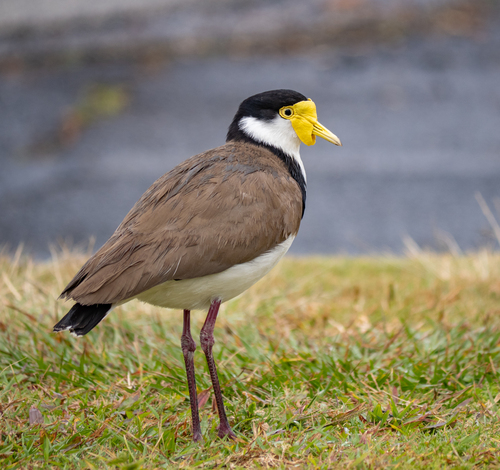
Masked Lapwing
The Masked Lapwing (*Vanellus miles*) is a distinctive, large shorebird native to Australia, New Guinea, and nearby islands. It is easily recognized by its prominent yellow facial wattles and black 'mask' extending from the forehead to the nape. This species plays a crucial role in wetland and open grassland ecosystems, primarily as an insectivore. Masked Lapwings are well-known for their bold and sometimes aggressive defense of their nests and young, often swooping at perceived threats, including humans. They are culturally significant in some regions, known for their loud, distinctive calls, often heard at night.
35-38 cm
Length
75-85 cm
Wingspan
Least Concern
Conservation Status
Distribution
The Masked Lapwing is found throughout Australia (including Tasmania), New Guinea, and nearby islands such as Timor and the Aru Islands. Two subspecies are recognized, with *V. m. miles* found in northern Australia and New Guinea, and *V. m. novaehollandiae* (often called the Spur-winged Plover) in southern and eastern Australia. They are generally non-migratory, though some populations may undertake local movements in response to rainfall.
Lifespan
Up to 20 years in the wild, but typically shorter.
Masked Lapwing's Habitat
Habitat Types
Open grasslands, Wetlands, Mudflats, Urban parks and playing fields, Agricultural areas
Climate Zones
Tropical, Subtropical, Temperate
Adaptations
Masked Lapwings are well-adapted to open habitats, with long legs for wading in shallow water and keen eyesight for spotting prey. Their bold coloration may serve as camouflage in certain environments, and their aggressive behavior helps protect their nests and young.
Variations
The two recognized subspecies, *V. m. miles* and *V. m. novaehollandiae*, differ primarily in the size of their facial wattles and the presence of a black shoulder bar in *V. m. novaehollandiae*. The southern subspecies (*novaehollandiae*) is also slightly larger.
Appearance
Breeding Plumage
Plumage remains relatively consistent throughout the year.
Seasonal Feather Changes
Minimal seasonal variation.
Sex Based Plumage Differences
Males and females have similar plumage.
Notable Features
Large, bright yellow facial wattles., Black cap extending down the nape., Sharp, yellow wing spurs (more prominent in *V. m. novaehollandiae*)., White underparts and brown upperparts.
Diet and Feeding
Primary Foods
Insects, Worms, Mollusks, Small crustaceans, Occasionally seeds
Foraging Behavior
Masked Lapwings primarily forage by walking and pecking at the ground, probing soft soil or mud with their bills. They are often seen foraging in open areas, including lawns and playing fields.
Specializations
Their long legs allow them to wade in shallow water to access aquatic prey. They also use foot-trembling to disturb insects.
Seasonal Diet Variations
Diet may vary slightly depending on the availability of prey, with a greater reliance on insects during the breeding season.
Behavior
Social Structure
Masked Lapwings are often seen in pairs or small family groups. During the non-breeding season, they may form larger flocks.
Communication
Loud, piercing 'kek-kek-kek' calls., A distinctive 'keer-keer-keer' alarm call., Visual displays, such as wing-spreading and bowing.
Migration
Generally non-migratory, although some populations may undertake local movements in response to rainfall or food availability.
Territorial or Group Behaviors
Highly territorial during the breeding season, aggressively defending their nesting sites. Outside of breeding, they are more tolerant of other individuals.
Conservation
Threats
Habitat loss due to urbanization and agriculture., Predation by introduced species (e.g., foxes, cats)., Disturbance by human activities.
Protection Programs
Some populations benefit from protected areas, such as national parks and reserves.
Local National Laws
Protected under state wildlife legislation in Australia.
Population Trend
Stable
Population Estimates
The global population is estimated to be between 1,000,000 and 2,500,000 individuals.
Interesting Facts
They are known for their aggressive defense of their nests.
Masked Lapwings will swoop at and even strike intruders, including humans, who approach too closely.
They possess sharp spurs on their wings.
These spurs are used in defense against predators and rivals.
They are sometimes called 'Spur-winged Plovers'.
This name refers to the prominent wing spurs, particularly noticeable in the southern subspecies (*V. m. novaehollandiae*).
Their chicks are highly precocial.
Meaning that they are able to walk and forage soon after hatching
Faqs about Masked Lapwing
Why do Masked Lapwings swoop at people?
They are fiercely protective of their nests and young and will swoop at anything they perceive as a threat.
Are Masked Lapwings dangerous?
While their swooping behavior can be intimidating, they rarely cause serious injury. The wing spurs can cause minor scratches.
What should I do if a Masked Lapwing swoops at me?
The best course of action is to move away from the nesting area calmly. Avoid direct eye contact and do not try to fight back.
Where can I find a Masked Lapwings?
Look for open habitats near water, but also in drier locations such as grasslands, playing fields and even airports.
Copyright @ Nature Style Limited. All Rights Reserved.
 English
English